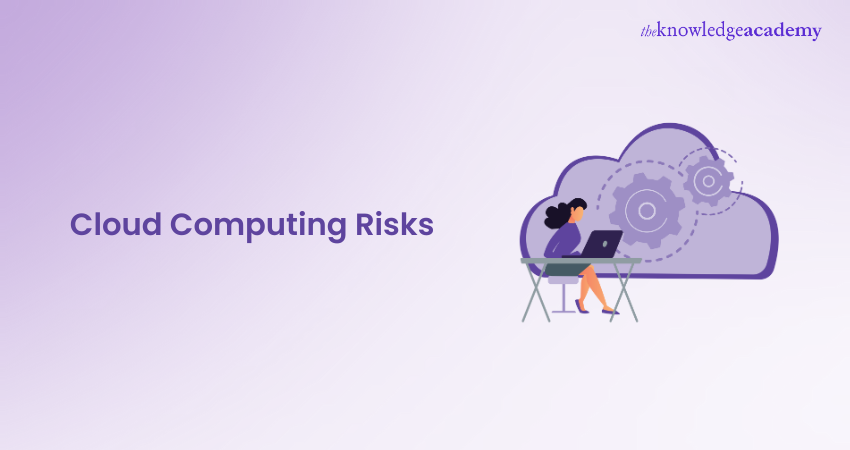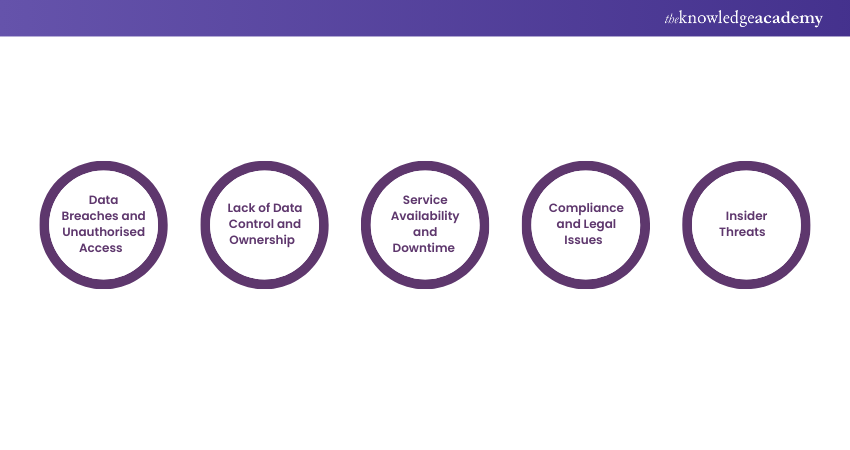We may not have the course you’re looking for. If you enquire or give us a call on +44 1344 203999 and speak to our training experts, we may still be able to help with your training requirements.
Training Outcomes Within Your Budget!
We ensure quality, budget-alignment, and timely delivery by our expert instructors.

Who would have thought about Cloud Computing becoming an integral part of businesses today? It has bestowed corporations and enterprises with a high level of scalability, cost-efficiency, and flexibility, alongside numerous other benefits. However, as every rose has its thorns, there are certain Risks of Cloud Computing that businesses should be aware of. These risks can cause severe breaches of security and raise data privacy concerns.
If you wish to learn about these risks in Cloud Computing and know how to implement appropriate security measures, this blog is all you need. Continue to delve into this blog to navigate potential challenges and risks in cloud computing and keep your digital assets safe!
Table of Contents
1) Overview of Cloud Computing
2) What are the top security risks of Cloud Computing?
a) Data breaches and unauthorised access
b) Lack of data control and ownership
c) Service availability and downtime
d) Compliance and legal issues
e) Insider Threats
3) Mitigation strategies for enhanced security
4) Conclusion
Overview of Cloud Computing
Cloud Computing technology refers to internet-based computing resources which work on a pay-as-you-go basis. It eliminates the need for businesses to invest in physical infrastructure and provides access to a common pool of configurable computing resources, including networks, servers, storage, applications, and services. You can access these resources remotely, scale them up or down as needed, and pay only for what they use.
Learn the details of different Cloud services with our Cloud Computing Courses!
What are the top Security Risks of Cloud Computing?
Risks of Cloud Computing refer to the potential threats and vulnerabilities that can compromise the security, availability, privacy, and compliance of data and services in the cloud environment.
Cloud Computing involves storing and processing data on remote servers owned and managed by third-party service providers. While there are numerous Benefits of Cloud Computing, such as scalability, cost-efficiency, and flexibility, it also presents certain serious security risks that organisations must be aware of and address promptly.

1) Data Breaches and Unauthorised Access
Data breaches and unauthorised access pose significant security risks to businesses employing Cloud Computing. Some common causes of data breaches and best practices for securing data in the cloud are as follows:
Data security: Data security is a crucial concern in Cloud Computing due to the potential for data breaches and unauthorised access. Safeguarding sensitive information and protecting intellectual property is paramount to maintaining the trust of customers and stakeholders.
Data breaches: Data breaches can occur due to various security factors. These involve weak authentication mechanisms, inadequate encryption practices, malicious attacks, insider threats, and vulnerabilities in the cloud provider's infrastructure or applications.
Best practices: To mitigate the risk of data breaches, organisations should implement robust security measures such as strong authentication protocols, encryption of data at rest and in transit, regular security audits, employee training on security best practices, and continuous monitoring of systems and networks.
2) Lack of data control and ownership
The cloud's lack of data control and ownership introduces security concerns for organisations. Some factors related to data ownership, risks associated with vendor lock-in, and strategies for maintaining control and ownership of data are as follows:
Data ownership: When organisations store their data in the cloud, they may face challenges regarding data control and ownership. Understanding the terms and conditions of the cloud service provider's agreement is essential to determine the extent of control and ownership over the data.
Vendor lock-in: Vendor lock-in refers to the situation where a business becomes heavily dependent on a particular cloud service provider, making it challenging to switch providers or migrate data. This lack of flexibility can pose security risks and hinder business operations.
Data control and ownership: To mitigate the security risks of vendor lock-in and lack of data control, organisations should consider strategies such as maintaining sufficient data backup copies, implementing data portability measures, conducting due diligence when selecting cloud providers, and negotiating clear data ownership terms in service agreements.
Master Cloud Infrastructure and Computing with Linux OpenStack Administration Training- sign up today!
3) Service Availability and Downtime
Service availability and downtime can harm business operations and overall security. Some availability and downtime factors are as follows:
Impact of service outages: Service outages and downtime in the cloud can have severe consequences on the business security. They can lead to disruptions in business operations, productivity loss, and negative customer experiences. Organisations must identify the potential impact of such incidents and have contingency plans in place.
Downtime and service disruptions: Downtime can result from several factors, including network failures, hardware malfunctions, software glitches, natural disasters, cyber-attacks, and maintenance activities by the cloud service. Understanding these causes is crucial for effective risk mitigation and implementing security measures.
Disaster recovery plans: To address service availability risks; organisations should consider implementing redundancy measures such as data replication across multiple geographical regions, load balancing, and failover mechanisms. Additionally, robust security and disaster recovery plans should be in place to ensure the timely recovery of services during an outage.
Try our Microservices Architecture Training and learn concepts of load balancing!
4) Compliance and Legal Issues
Navigating compliance and legal challenges is crucial when adopting Cloud Computing. Here are the legal risks as well as details on ensuring adherence to applicable laws and standards:
Regulatory compliance challenges: Cloud Computing introduces complexities related to regulatory compliance. Organisations must comply with industry-specific regulations, data protection laws, privacy requirements, and compliance frameworks to ensure applicable standards adherence.
Cross-border data transfers: Storing data in the cloud may involve cross-border data transfers, which can raise security concerns about data sovereignty and compliance with regulations governing the storage and data processing of data in different jurisdictions.
Compliance with laws and standards: Organisations should work closely with their cloud service providers to understand their compliance certifications, data handling practices, and security controls. They must also assess the provider's ability to comply with specific legal and regulatory requirements.
Insider Threats
Insider threats pose significant risks to cloud computing environments. Here are some critical aspects related to addressing these threats:
Implementing strict access controls: Organisations must enforce stringent access controls to limit the data and systems that employees or contractors can access. Role-based access control (RBAC) and the principle of least privilege (PoLP) should ensure individuals only have access to the information necessary for their roles.
Continuous monitoring: Monitoring user activities within the cloud environment is crucial to detect and respond to suspicious behaviours promptly. In addition, utilising security information and event management (SIEM) systems can help track and analyse user actions to identify potential insider threats.
Conducting thorough background checks: It is crucial to perform comprehensive background checks on employees and contractors before granting them access. It can help protect sensitive data and prevent insider threats. Regularly updating these checks and cultivating a security awareness culture can further mitigate the risks associated with insider threats.
6) Data Sovereignty
Data sovereignty refers to the legal and regulatory requirements where data is stored and processed. Here are some essential considerations for the same:
Understanding data residency requirements: Organisations must be aware of the data residency requirements specific to their countries. You should ensure that cloud providers comply with these local laws to help prevent legal issues related to data storage and processing.
Ensuring provider compliance: It is crucial to choose cloud providers that adhere to international and local data protection laws. To help maintain regulatory compliance, organisations should perform regular reviews of the provider's compliance status and policies on data sovereignty.
Establishing clear data management policies: Organisations should develop and enforce clear policies outlining how data is stored, accessed, and transferred. These policies should be reviewed and updated regularly to ensure ongoing compliance with evolving data sovereignty regulations.
Try our Terraform Training to gain familiarity with loops, syntax and statements!
Mitigation Strategies for Enhanced Security
Mitigation strategies refer to the proactive security measures and actions taken to reduce or eliminate the risks and vulnerabilities associated with a particular domain or activity. In Cloud Computing, mitigation strategies allow the organisations to address the potential threats and challenges of Cloud Computing Risks. These strategies are described as follows:
Authentication and access controls: Implementing robust authentication and access controls is vital to cloud security and protecting its resources from unauthorised access. Authentication methods like multi-factor authentication and Role-Based Access Control (RBAC) helps to ensure secure and reliable cloud environments.
Encrypting data: Encrypting data is an essential security practice to safeguard sensitive information in the cloud. It holds great significance for cloud safety, with specific actions. These actions involve encryption at rest and encryption in transit which are crucial to protect data from unauthorised disclosure or interception.
Auditing cloud services: Regular monitoring and auditing of cloud services help detect potential security threats and ensure compliance. Implementing intrusion detection systems and conducting regular audits can help you identify and take precautions for security vulnerabilities.
Conducting vulnerability assessment: Vulnerability assessments and penetration testing play a crucial role in identifying weaknesses and validating the security controls’ effectiveness in cloud environments. Conducting thorough assessments and testing can help you to proactively identify and remediate vulnerabilities.
Developing incident response: Having well-defined incident response and business continuity plans is essential for effectively managing security incidents and minimising business disruptions. A few of these response strategies include incident detection, response, recovery, and the establishment of business continuity measures.
Conclusion
We hope this blog helps you to understand the most prevalent Risks of Cloud Computing. While Cloud Computing offers numerous benefits, organisations must be aware of the associated threats and take proactive steps to mitigate them. By implementing strong security measures, such as encryption and regular audits, businesses can better protect their data stored in the cloud.
Gain a comprehensive foundation in Google Cloud services with Google Cloud Platform Fundamentals Course- join now!
Frequently Asked Questions

Cloud computing offers high scalability, cost savings, and remote accessibility, making it ideal for businesses. However, it also poses risks, which include data security, potential downtime, and dependency on internet connectivity.

The significant threats to the Cloud include data breaches, account hijacking, insider threats, and insecure APIs. Other risks involve data loss, insufficient due diligence, and denial-of-service attacks.

The Knowledge Academy takes global learning to new heights, offering over 30,000 online courses across 490+ locations in 220 countries. This expansive reach ensures accessibility and convenience for learners worldwide.
Alongside our diverse Online Course Catalogue, encompassing 17 major categories, we go the extra mile by providing a plethora of free educational Online Resources like News updates, blogs, videos, webinars, and interview questions. By tailoring learning experiences further, professionals can maximise value with customisable Course Bundles of TKA.

The Knowledge Academy’s Knowledge Pass, a prepaid voucher, adds another layer of flexibility, allowing course bookings over a 12-month period. Join us on a journey where education knows no bounds.

The Knowledge Academy offers Cloud Computing Courses, including Cloud Computing Trainings and Linux OpenStack Administration Training, among others. These courses cater to different skill levels, providing comprehensive insights into How to Get a Job in Cloud Computing.
Our Cloud Computing Blogs cover a range of topics related to Google Clouds Certification, offering valuable resources, best practices, and industry insights. Whether you are a beginner or looking to advance your Cloud Computing skills, The Knowledge Academy's diverse courses and informative blogs have you covered.
Upcoming Cloud Computing Resources Batches & Dates
Date
 Cloud Computing Training
Cloud Computing Training
Thu 16th Jan 2025
Thu 6th Mar 2025
Thu 22nd May 2025
Thu 24th Jul 2025
Thu 4th Sep 2025
Thu 11th Dec 2025







 Top Rated Course
Top Rated Course



 If you wish to make any changes to your course, please
If you wish to make any changes to your course, please


